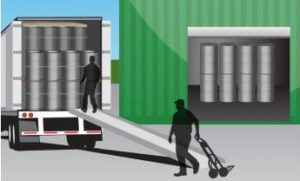
The Pipeline and Hazardous Materials Safety Agency (PHMSA) tracks transportation incidents for all packaging types.1 The information collected on the report is used by PHMSA and other agencies to mitigate risk, analyze gaps and enhance safety.
An analysis of recent incident reports show that proper handling of containers could have prevented many events. In fact, damage from forklifts, dropping a package, inadequate blocking and bracing and human error consistently rank as some of the top reasons for transportation incidents with packaging.
Each year steel drums, weighing 400 to 600 pounds when filled, transport a range of hazardous and non-hazardous materials around the world. All successful deliveries typically have one thing in common – well-trained employees implementing well-established best practices and efficiently handling steel drums. Following proper procedures when handling this packaging can be the difference between an average afternoon and an incident.
When it comes to loading or unloading, moving drums on pallets requires proper attention. Using forklifts to move steel drums on pallets rather than rolling drums by hand helps to avoid personal injury and drum damage. Care must be taken when using forklifts to avoid accidental puncture of the drum and release of its contents. Pallet quality is also important to prevent drum punctures or shifting during transport. Prior to use, one should ensure pallets do not have sharp objects protruding, such as nails.
Once loaded onto a trailer, proper blocking and bracing of the drums is critical to prevent shifting and damage during transit. Eliminating movement within the container or truck will help ensure drums arrive in their pre-shipping condition. Advice on proper blocking and bracing is available from the Institute of Packaging Professionals (IOPP) by clicking this this link.
The closure of a container is vital to avoiding spills and damage to steel drums. By carefully sealing and checking a drum and following Department of Transportation closure instructions provided by the manufacturer, employees can prevent unnecessary spills and leakage.
The use of proper equipment by trained employees is the key to safely handling steel drums. As with any work process, it is recommended that procedures are reviewed and vetted by your own internal safety committee prior to use or adoption.
Click Here to Download Issue 9



